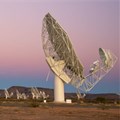#Artemis2025: First woman on the moon? SA's epic tourism venture

This initiative forms part of South Africa's newly launched national astro-tourism strategy.
Spearheaded by the Department of Tourism in collaboration with the Department of Science and Innovation, it seeks to capitalise on the presence of key astronomical facilities in South Africa and aims to position the country as a leading astro-tourism destination.
While Prince Albert and the Cederberg are among those already positioned as astro-tourism destinations, the national strategy aims to incorporate The Northern Cape and Matjiesfontein as the focal point of this strategy. This will likely involve a variety of initiatives such as tour guides, stargazing events, public talks and facility visits to engage and educate visitors.
These visits will educate tourists about the scientific research being conducted there and the global significance of these observatories.
“Astro-tourism has been gaining recognition globally as a unique and exciting form of tourism. It is positive for the destination to see that the national Department of Tourism is aiming to harness its potential by developing a strategic framework to drive the industry forward,” said Monika Luel, chief tourism officer at Wesgro.
Boosting lunar tourism
A development such as the one in Matjiesfontein offers considerable advantages for boosting tourism. To this end, Matjiesfontein will host one of three Lunar Exploration Ground Sites (Legs), with large antennae ranging from 18m to 24m in diameter. These antennae will enable near-continuous communication between the Artemis spacecraft and future lunar explorers.
The strategic location in South Africa, along with two other ground stations in New Mexico and Australia, ensures the moon is always in view from at least one station, crucial for maintaining direct-to-Earth communication over vast distances.
This continuous communication will support both the exploration of the moon and long-term missions that will serve as stepping stones to Mars.
The facility also relieves pressure on Nasa's existing Deep Space Network, which is already heavily used for numerous space missions.

The national astro-tourism plan will also highlight the following key astronomical facilities:
Minister @PatriciaDeLille Deputy Minister @Maggie_Sotyu visited the Square Kilometre Array outside Carnarvon, NC as part of the National Astro-Tourism Strategy opening for public comment from 27 Sept to 27 Oct 2024.#tourismmonth2024#experiencethenorthencape#astrotourism pic.twitter.com/SlxcTi8fG5
— Dept of Tourism (@Tourism_gov_za) September 27, 2024
Harnessing dark skies
The launch of this national astro-tourism initiative represents South Africa's broader ambition to leverage its astronomical assets and unique Southern Hemisphere vantage point for both scientific progress and tourism development.
It aligns with the Office of Astronomy for Development’s programme, which focuses on sustainable, local, and socio-economic development through astronomy.
The flagship initiative explores how astronomy can serve as a catalyst for socio-economic progress, with astro-tourism being one of its key projects. The mission of this project is to empower rural communities to leverage their dark skies and rich cultural and natural heritage to enhance local economic growth.
“[Attractions like these] will benefit the tourism value chain as it will bring visitors into the area to experience the astro-tourism offerings and spend the night or weekend, which ultimately leads to consumption of surrounding hospitality and tourism offerings – not just hotels but farm stays, restaurants and even our much-loved padstals selling local produce," said Luel.
“This type of project will most definitely have an impact on tourism and we are excited to watch it unfold."















